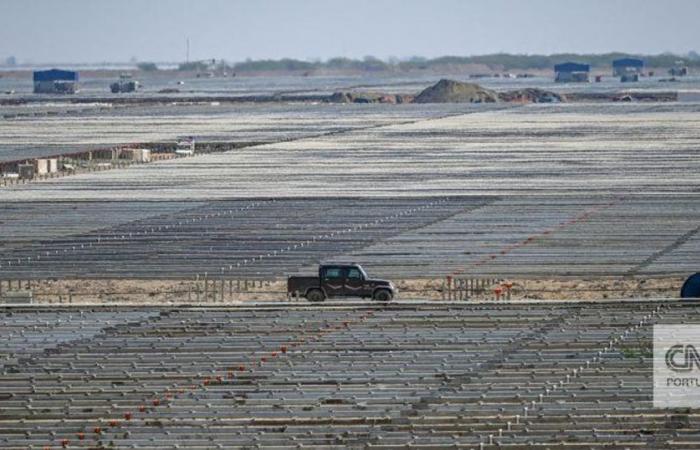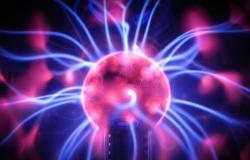
The Adani Group’s Khavda Renewable Energy Park is being built in the Indian state of Gujarat. The dimensions are impressive. But the increase in energy consumption in India will also be
Five times the size of Paris. Visible from space. The largest energy plant in the world. Enough electricity to power Switzerland.
The scale of the project that is transforming an arid salt flat area on the edge of western India into one of the most important sources of clean energy on the planet is so large that the person responsible cannot keep pace.
“I don’t even do the math anymore,” Sagar Adani told CNN in an interview last week.
Adani is the chief executive officer of Adani Green Energy Limited (AGEL). He is also the nephew of Gautam Adani, the second richest man in Asia, whose fortune of 100 billion dollars (92.3 billion euros) comes from the Adani Group, the largest coal importer in India and one of the main miners in this country. dirty fuel. Founded in 1988, the conglomerate has businesses in areas ranging from ports and thermal power plants to media and cement.
Its clean energy unit, AGEL, is building a vast solar and wind power plant in the Indian state of Gujarat, at a cost of around $20 billion (€18.5 billion). When completed in about five years, it will be the world’s largest renewable energy park and is expected to produce enough clean electricity to power 16 million Indian homes.
The success of the Khavda Renewable Energy Park is critical to India’s efforts to reduce pollution and achieve its climate goals, while meeting the growing energy needs of the world’s most populous nation and fastest-growing large economy. Coal still accounts for 70% of electricity produced in India.
An employee works on a blade of a wind turbine produced at an Adani Group factory in the Indian city of Mundra. Punit Paranjpe/AFP/Getty Images
Situated just 30 kilometers from one of the most dangerous borders in the world, which separates India and Pakistan, the park will cover more than 518 square kilometers and will be the largest power plant on the planet, regardless of the energy source, AGEL said.
“Such a large region, such a clear region, there is no wildlife, there is no vegetation, there is no habitation. There is no better alternative for the use of this land,” Adani said.
The group’s big green plans have not been dented by the turbulent year it has had since January 2023, when an American short-selling fund (short seller), Hindenburg Research, accused him of committing fraud for decades.
The Indian conglomerate denounced the Hindenburg report as “baseless” and “malicious”. But this failed to stop an impressive collapse of the stock market which, at one point, saw more than 100 billion dollars (92.3 billion euros) disappear from the value of its listed companies. Gautam Adani’s personal fortune was also affected, falling by more than $80 billion (€74 billion) in the month following the report’s publication.
But the tycoon has since recovered and the group is now investing billions in the clean energy sector.
It plans to invest 100 billion dollars (93.2 billion euros) in the energy transition over the next decade, with 70% of investments destined for clean energy.
A necessity for 1.4 billion people
The Adani Group’s commitment to clean energy comes at a time when India has set ambitious climate goals. Prime Minister Narendra Modi has promised that renewable sources, such as solar and wind energy, will meet 50% of India’s energy needs by the end of this decade.
In 2021, Modi promised that India would achieve net-zero emissions by 2070, which is still a couple of decades later than developed economies.
The government has set a target of 500 gigawatts (GW) of electricity production capacity from non-fossil fuels by 2030. AGEL, the country’s largest renewable energy company, aims to provide at least 9% of that capacity, with around 30 GW generated just from its Khavda park, in Gujarat.
Not transitioning to renewable energy is not an option, Adani said.
“There is no other option for India but to start doing things on a scale and size never before imagined,” said the 30-year-old businessman.
An employee inspects solar panels at an Adani Group factory in Mundra. Punit Paranjpe/AFP/Getty Images
This is because energy demand will explode in the coming years.
India is the third largest energy-consuming country in the world, although its energy consumption and emissions per person are less than half the global average, according to data from the Paris-based International Energy Agency (IEA).
This situation could change quickly. Thanks to rising incomes, energy demand has doubled since 2000, with 80% of that demand still met by coal, oil and solid biomass. Over the next three decades, the rapidly expanding economy will see the highest growth in energy demand of any country in the world, according to the IEA.
“If India does what China did, if India does what Europe did, if India does what the United States did, then we are all going to be in a very, very dark climate future,” Adani said, referring to the historical use of fossil fuels during the development of these countries.
His predictions are not dramatic. India is in a comfortable position to grow at an annual rate of at least 6% in the coming years, analysts say, and could become the world’s third-largest economy before the end of this decade.
India is expected to add the equivalent of one London per year to its urban population over the next 30 years. Electricity demand will skyrocket.
As it develops and modernizes, its urban population will skyrocket, leading to a massive increase in the construction of homes, offices, stores and other buildings. According to analysts, India is expected to add the equivalent of one London per year to its urban population over the next 30 years.
Electricity demand is expected to soar in the coming years due to factors ranging from improving living standards to climate change. The latter have been causing deadly heat waves across India and, consequently, the ownership of air conditioners is expected to see a sharp increase in the coming years.
By 2050, India’s total electricity demand from residential air conditioners is expected to exceed total energy consumption across Africa, according to the IEA.
India cannot rely on fossil fuels to meet its growing needs without disastrous consequences for efforts to combat the climate crisis.
“If we imagine that 800 GW of coal-fired thermal capacity is being added… this, in itself, will annihilate all the other sustainable energy initiatives that are taking place around the world, in terms of carbon emissions”, said Adani.
A worker walks past rows of solar panels at the Khavda Renewable Energy Park. Punit Paranjpe/AFP/Getty Images
Both sides of the street
The conglomerate’s green plans are impressive, but climate experts criticize its massive and ongoing investments in fossil fuels.
“Gautam Adani continues to walk both sides of the street,” said Tim Buckley, director of Sydney-based think tank Climate Energy Finance.
Not only is the Adani Group one of the largest developers and operators of coal mines in India, it also operates the controversial Carmichael coal mine in Australia, which has faced fierce opposition from climate change activists who say it is a ” death sentence” for the Great Barrier Reef.
“Instead of investing billions in new fossil fuel projects, India would be much better served if Adani invested 100% of its efforts and resources in developing low-cost, zero-emission technologies,” Buckley added.
This is not an option at the moment, Adani said.
Another view of the Khavda Punit Renewable Energy Park Paranjpe/AFP/Getty Images
In India, more than 600 million people “will move into middle and higher incomes in the next decade, decade and a half”, he said. “They cannot be deprived of basic energy needs.”
Everyone would be pleased if we could “have 100% of that energy supplied by sustainable energy sources…[mas]… in practice, that’s not an option” at this point, he added.
He also said that activists in developed countries, which have historically emitted more greenhouse gases, are often unable to understand the enormous challenge India faces in growing its economy and clean energy industry at the same time. .
“I think it’s also very important to respect the fact that each country has the right to ensure that the people of their own country are well served from an energy point of view,” said Adani.
“Is India producing a little coal? Yes, of course yes. But is India producing a lot of renewable energy? Yes, there is no doubt,” he added.
Tags: coal billionaire building worlds largest clean energy plant times size Paris supply Switzerland
--




